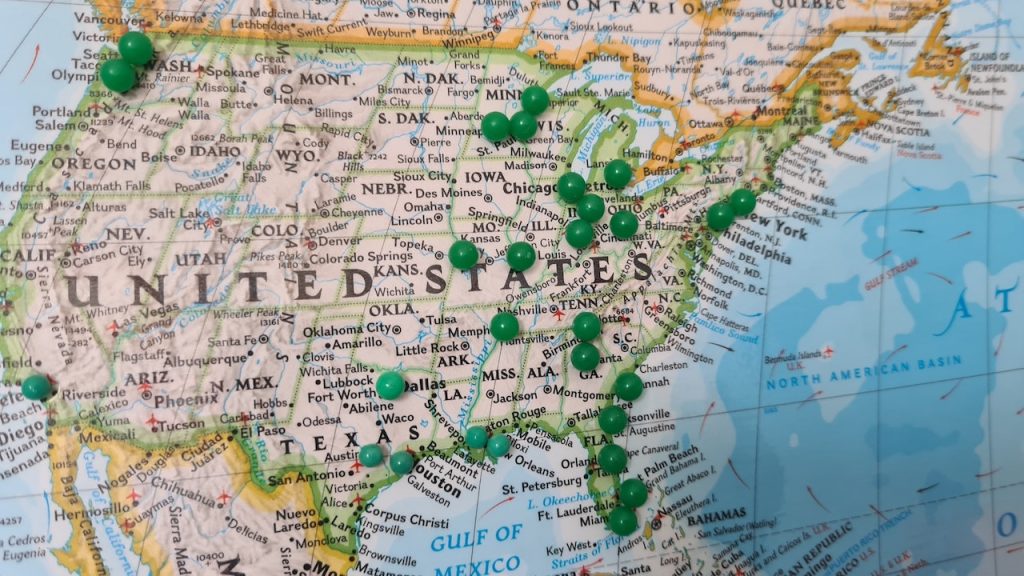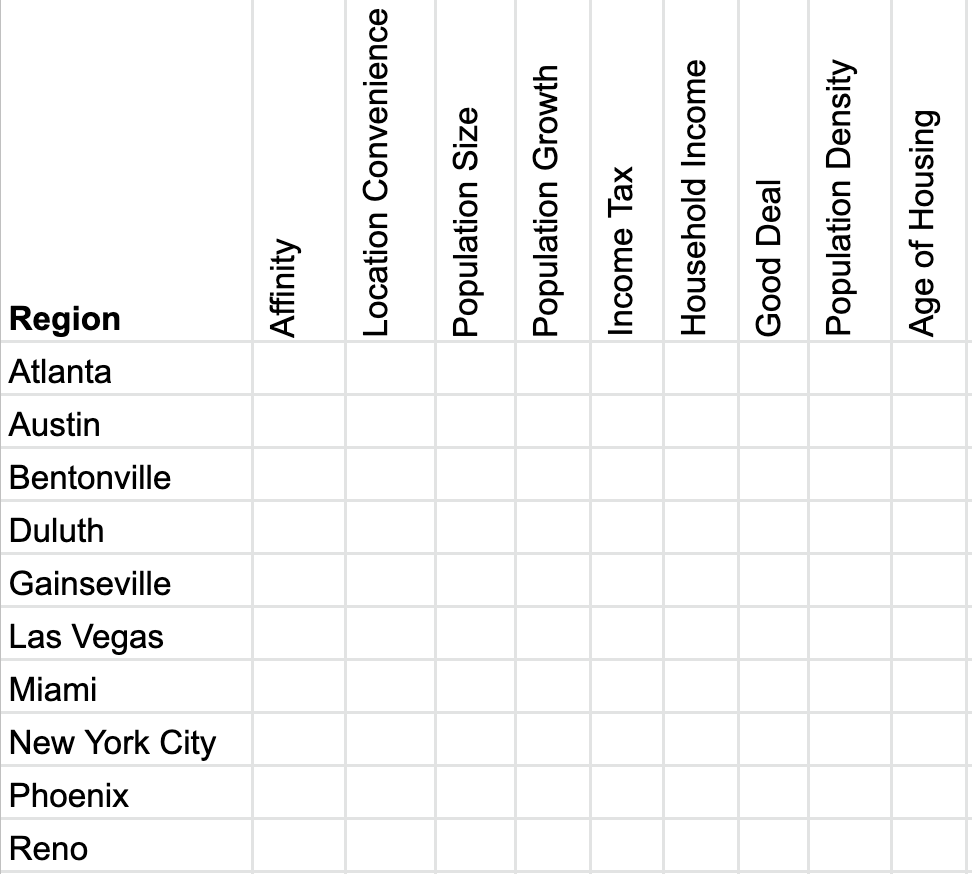- How to identify a list of potential cities where you can source a business acquisition
- The factors that Acquira uses to rank locations by how friendly they are to business acquisition
- How to create and rank your list of target business acquisition locations
Buying a business is not just about P&L reports and balance sheets. There are more things to consider than simply EBITDA margins and whether the business has the right permits.
There is one thing that many Acquisition Entrepreneurs forgot to consider as they embark on their business buying journey: Where the heck are they going to find a business?
Note: “AE” is the name we’ve given to the Acquisition Entrepreneurs we work with.
Many AEs begin the search close to home and, for a large percentage of those people, the hunt will not go beyond a specific radius: where they lay their heads at night. Figuring out how to find a business to buy is often the first thing you do after deciding to buy a business. If they have school-age children or roots in the community, the thought of picking up and leaving in order to buy a business can seem outlandish.
After all, while you probably know a lot about your local community or city, you may not know how well it compares to other regions regarding attractiveness as a business buying location.
What Is “Location Agnostic?”

We have learned that those AEs who are more location agnostic often have a greater chance of success.
When you’re open to buying a business in multiple areas, we refer to this as being location agnostic. We have learned that those AEs who are more location agnostic often have a greater chance of success.
In fact, we recommend that Acquisition Entrepreneurs be rigid with the industry of their target business OR the location, but never both. So if family or other commitments keep you tied to a specific region, you should try to be flexible with the industry. Conversely, if you want to buy a specific business, you should be open to relocating.
In this article, we will walk you through deciding what locations to look in as you embark on your business-buying journey. Once you’ve locked onto a specific region or created a list of different possibilities, this can help you refine your search and investment thesis.
Step 1: Create A List of Cities
We recommend that you look for cities in the United States with a population of over 100,000 people. Once you’ve found a list you can start ranking them based on various criteria.
Step 2: Understand The Location Ranking Factors
There are innumerable ways to compare locations – anything from how much the local GDP is to how good the local baseball team is. But we’ve identified seven factors that we believe should top the list for how you rank your cities.
Factor #1: Affinity
This is basically a fancy way of saying “How much do you like it there?” If you’re not a fan of heat, you’ll likely want to stay away from Texas. Can’t stand the cold? Stay out of the Northeast.
This is actually the most important factor for you to consider. If you don’t like a place, you’ll be miserable if you move there. Here are some things to think about:
- Do you visit this place often? (ie, your parents in Florida)
- Do you vacation there regularly? (eg, a ski resort in Colorado)
- Does it have the weather you like?
- Does it offer access to other activities you enjoy?
- Is it congenial to your politics, if that’s important to you?
If it offers any of the above it can make your overall business ownership experience much more enjoyable.
Factor #2: Location Convenience
How easy is the place to get to? Whether the location is within driving distance or a short, direct flight from your primary residence, getting to the business within a few hours can make it much more appealing as an acquisition option.
Factor #3: Population Size

Larger regions generally have more opportunities for growth and expansion. It may seem like a great idea to corner the roofing market in a small region like Carson City, Nevada. Still, it will be difficult to grow that business significantly unless you plan to pivot to a different sector or expand geographically.
The downside to a place with a larger population is that it tends to attract more competition and foster more innovation, which means things move faster.
So if you’re aggressive and looking to scale, focus on a region with a larger population. If you’d rather find a stable business that is more upside-constrained, look at regions with a smaller population.
Factor #4: Population Growth
Major demographic shifts are happening across the United States right now. For instance, one of the major trends is people from the North and Central US move to the Southern states (both Southwestern and Southeastern).
Buying a business in a high-growth region has several benefits, including more potential customers, fewer customers that are already deeply loyal to existing businesses, and an easier time identifying and hiring talent.
Factor #5: Income Tax
State income tax rates range from 0% (in seven states) to as high as 13.3% in California. Buying a business in a low-income tax or no-income-tax state can have several benefits.
For many business owners (especially those who eventually exited the business), a C-corporation may be the best corporate structure. With a C-corporation, that business owner in California could face a tax rate of 26.6% (13.3% personal + 13.3% corporate) on their income. Compare that to a business located just over the state lines in Nevada, and that owner would have a 0% corporate tax rate.
Low-tax and no-tax states are also primed for a wave of population growth, especially from high-income residents that are leveraging the new normal of working from home to relocate to a low-tax state.
Factor #6: Household Income
By their very nature, regions with higher household incomes can afford to pay more for your products and services thanks to their residents' higher disposable income. A higher cost of living may offset this but overall, companies in regions with higher incomes can command higher prices – or focus on goods with higher prices/margins.
Factor #7: You Find a Great Business
You should always consider the availability of businesses to buy. While a bit of patience goes a long way, there’s no denying that an amazing deal on a great business can counter the absence of many other benefits (such as population growth or income statistics).
Find a great business with a positive brand reputation, high cash flow, and low multiple that isn’t in a location you’ve ever been to, in a small city with no cultural attraction, or inconveniently located four hours away. It can still be an attractive acquisition target.
Factor #8: Population Density
As The Atlantic points out, “Density is a key factor in innovation and economic growth.” Population clusters have played a role in some of the biggest leaps forward in the industrial age, whether in the automotive industry in Detroit or filmmaking in Los Angeles. When businesses, industries, people, and other economic assets are located within a relatively small geographic area, it tends to spur innovation and economic growth.
Factor #9: Age of Housing
The typical age of a home in an area could impact how successful a home services business can be in a region. For example, if a majority of the houses in a specific region were built within the last 10 years, this could have a detrimental effect on an HVAC business, simply because no one is going to need to replace their furnaces in the near future.
Step 3: Rank & Sort
Once you’ve compiled a list of regions that you’re interested in and you have an understanding of the ranking factors, it’s time to start seeing how they stack up against one another.
In our training, we provide you with a pre-analyzed database of all US cities with a population over 100,000 that you can use to filter out certain criteria that don’t apply to you. To learn more about that, check out The Accelerator.
If you don’t have access to our pre-analyzed database, you can write out all of the cities you’re considering in a column on a spreadsheet. Then list the factors along the top. Once you’ve given a rank to each factor for each region, you can start eliminating the ones that definitely don’t meet your investment thesis.

Step 4: Zero In
As you tally up the scores for the various regions you’re looking at, certain areas will naturally begin to disqualify themselves. Either the weather sucks or it’s too close to your in-laws’ place. Whatever the reason, you will soon have a list of regions throughout the United States where you will concentrate your search.
The Difference Between Must-Haves and Nice-to-Haves
There are several factors that any Acquisition Entrepreneur worth their salt should consider when analyzing a business. We often break these down into “Must-Haves” and “Nice-to-Haves.”
Must-haves are deal-breakers. These are traits that, if a business doesn’t possess, you simply won’t buy it. For example, a must-have could be a business with good company culture. But how do you define that? You might look at how much employee turnover there has been over the last 12 months. A high employee turnover could indicate that there’s something wrong with the company.
Nice-to-haves are more negotiable traits. It would be nice to have a business with an existing digital marketing strategy, but that is by no means a deal breaker.
Location is one of those strange factors that could fall into either category depending on the individual AE. For some, it might be non-negotiable to buy in a low-tax state while others might be open to any location as long as the price is right.
As you start to look into how to buy a business, you should think long and hard about your must-haves and nice-to-haves and be able to define them to anyone who asks. This will make the whole process much simpler in the long run.
Conclusion
Finding a small business for sale takes a lot of work. It’s much more complicated than simply typing “business for sale in Las Vegas” into Google. You need to systematically reach out to brokers or contact businesses within a region to see if they’re interested in selling.
Before you begin cold-calling owners, you should have a well-defined sense of where you want to look.
Have you ever moved to a new location for a job? We’d love to hear your story in the comments below.
If you need help defining your investment thesis or you just want to start your business buying journey now, schedule a call with us through the form below and someone will be in touch shortly to explain how we can help.
Key Takeaways
- Being location agnostic will always improve your chances of finding a business.
- Be rigid with the industry of your target business OR the location, but never both.
- Look for regions with a population above 100,000.
- Rank each region based on the seven factors to refine your geographical search.
- Define your must-haves and nice-to-haves in the early stages of your acquisition journey.
Acquira specializes in seamless business succession and acquisition. We guide entrepreneurs in acquiring businesses and investing in their growth and success. Our focus is on creating a lasting, positive impact for owners, employees, and the community through each transition.



